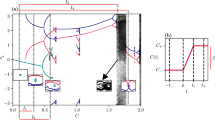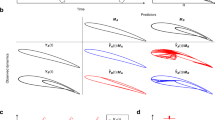Abstract
THE notion of determinism in classical dynamics has been eroded since Poincaré's work1 led to the recognition that dynamical systems can exhibit chaotic behaviour, in which small perturbations grow exponentially fast. For a chaotic system, ubiquitous measure-ment errors, noise and computer round-off severely limit the time over which, given a precisely defined initial state, one can predict the detailed subsequent evolution. Practically speaking, the behaviour of such systems is quantitatively non-deterministic. Nevertheless, as the state of the system tends to be confined to an 'attractor' in phase space, at least its qualitative behaviour is predictable. Another challenge to determinism arises, however, when a system has competing attractors towards which an initial state may be drawn. Perturbations make it difficult to determine the fate of the system near the boundary between sets of initial conditions (basins) drawn toward different attractors, particularly if the boundary is geometrically convoluted2. Recently, mathematical mappings were found3 for which the entire basin of a given attractor is riddled with 'holes' leading to a competing attractor. Here we present the first example of a physical system with this property. Perturbations in such a system render uncertain even the qualitative fate of a given initial state: experiments lose their reproducibility. We suggest that 'riddled' systems of this kind may be by no means uncommon.
This is a preview of subscription content, access via your institution
Access options
Subscribe to this journal
Receive 51 print issues and online access
$199.00 per year
only $3.90 per issue
Buy this article
- Purchase on Springer Link
- Instant access to full article PDF
Prices may be subject to local taxes which are calculated during checkout
Similar content being viewed by others
References
Poincaré, H. Les Méthodes Nouvelles de la Mécanique Céleste Vols. 1–3 (Gauthier-Villars, Paris, 1892, 1893, 1894). English translation (Am. Inst. of Phys., Colchester (Vermont), 1993).
McDonald, S. W., Grebogi, C., Ott, E. & Yorke, J. A. Physica 17D, 125–153 (1985).
Alexander, J. C., Kan, I., Yorke, J. A. & You, Z. Int. J. Bifurcations Chaos 2, 795–813 (1992).
Guckenheimer, J. & Holmes, P. J. Nonlinear Oscillations, Dynamical Systems, and Bifurcations of Vector Fields 22–27 (Springer, New York, 1983).
Duffing, G. Erzwungene Schwingungen bei Veränderlicher Eigenfrequenz (Vieweg, Braunschweig, 1918).
Moon, F. C. & Holmes, P. J. Sound Vibr. 69, 285–296 (1979).
Milnor, J. Commun. math. Phys. 99, 177-1985).
Author information
Authors and Affiliations
Rights and permissions
About this article
Cite this article
Sommerer, J., Ott, E. A physical system with qualitatively uncertain dynamics. Nature 365, 138–140 (1993). https://doi.org/10.1038/365138a0
Received:
Accepted:
Issue Date:
DOI: https://doi.org/10.1038/365138a0
This article is cited by
-
A special type of codimension two bifurcation and unusual dynamics in a phase-modulated system with switched strategy
Nonlinear Dynamics (2012)
-
Understanding Coin-Tossing
The Mathematical Intelligencer (2010)
-
Bifurcation analysis of a metapopulation model with sources and sinks
Journal of Nonlinear Science (1996)
Comments
By submitting a comment you agree to abide by our Terms and Community Guidelines. If you find something abusive or that does not comply with our terms or guidelines please flag it as inappropriate.



